Marine and fishery sectors in Indonesia are still dominated by men, as women fishers receive less acknowledgement and official support such as subsidies and insurance coverage. Nevertheless, women continue to be actively involved in downstream activities, such as post-harvest handling, selling, processing, storage, packaging and marketing, while also providing labour in both commercial and artisanal fisheries.
Women in the Arafura and Timor Seas (ATS) region have been actively involved in fishing and contributing to the processing and marketing of fish products for a long time. However, their contributions have often been ignored or undervalued, and they face difficulties in accessing resources, information and markets, which limits their potential to contribute to sustainable livelihoods. There are opportunities to help women engage in the fishing industry more, including providing targeted training and capacity-building programs, better access to credit and finance, and recognising the benefits of gender-equitable fisheries management.
To help improve the situation and raise the living standards of ATS inhabitants, the Arafura and Timor Seas Ecosystem Action Phase 2 (ATSEA-2) Project is working to promote sustainable development in the region by providing training for home-based small businesses run by women and capacity building for gender empowerment and community welfare in the district through seaweed. The Project aims to safeguard the livelihoods and prosperity of coastal people, particularly in transboundary areas, through the implementation of sustainable integrated concepts.
To celebrate International Women’s Day 2023, the Project set out to compile stories from the field, to highlight the vital role played by women in the marine and fisheries sector in the ATS region, which includes Indonesia, Timor-Leste and Papua New Guinea.
Women Improving Family Economies by Processing Fish Products in Papua, Indonesia
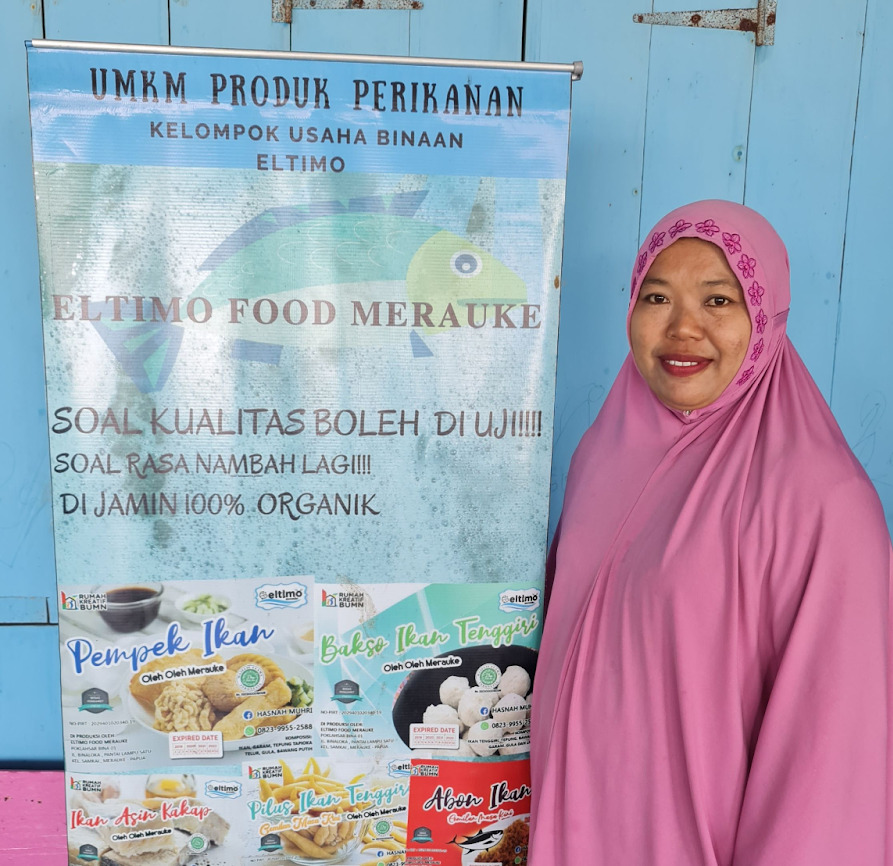
Merauke, the capital city of the South Papua Province in Indonesia is one of the main project sites for ATSEA-2. Here, the team has a close working relationship with many fishers, one of whom is a woman named Hasnah. Hasnah is a respected member of her community who processes fish products, particularly snapper and mackerel. After her husband’s fishing boat sank, he switched to transportation, but Hasnah continued working in the fishing industry. With support from the Merauke District Fisheries Service, she formed KUB Eltimo, a business group involved in training, exhibitions and marketing of their products. They make various fishery products that are popular in local markets and also serve as an information hub for the surrounding households. Hasnah helps to disseminate information and mobilise women in outreach activities, which helps fisherfolk to run their operations more effectively. With support from the ATSEA-2 Project, KUB Eltimo can provide additional support in managing fisheries and other coastal and marine resources in Merauke.
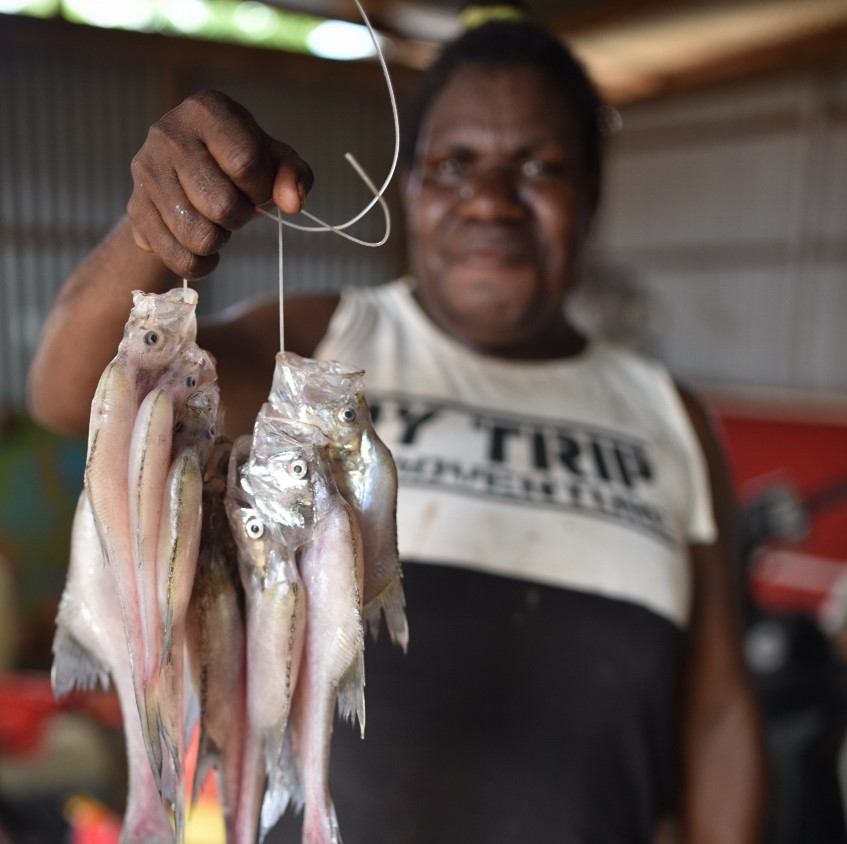
On the other side of South Papua Province, the ATSEA-2 Project team also met with Mama Elizabeth Limai, a small-scale fisher from Kumbe, South Papua, who has been fishing for glassfish, white croaker, snapper, threadfin and shrimp since she was 17 years old. She wakes up early every morning to fish with her husband and sells around 10 kilos of fresh fish locally. In the past five years, she has seen some worrying changes – the beach has become dirty and polluted, making it more difficult to catch fish.
“I normally catch ikan kaca (glassfish), gulama (white croaker), kakap (snapper), kurau (threadfin) and udang (shrimp),” she explains. Today, a bundle of glassfish hangs from her shoulder, while her bright-eyed daughter, Mariana, stands nervously by her side.
Elizabeth and Chris have been fishing this way for the past five years. But even in that short space of time, they’ve seen changes.
“It’s getting more difficult to catch fish nowadays, because the beach here has become dirty and polluted,” explains Elizabeth. She has noticed her catch getting smaller and smaller, as the fish are scared away by coastal pollution. “It didn’t used to be like this; we need to clean up the beaches here, so the fish will return.”
Women Fishers in Rote Ndao Adapt to Climate Change while Leveraging Alternative Livelihoods

Heading west from Papua, the ATSEA-2 Project team successfully met with some women fishers that could be the agents of change in Rote Ndao District, East Nusa Tenggara; another key working area for the project in Indonesia. According to a 2020 report by the Indonesian Ministry of Marine Affairs and Fisheries (MMAF), the poverty rate in East Nusa Tenggara is one of the highest in the country, with over 70% of the population living below the poverty line. The coastal communities in East Nusa Tenggara rely heavily on fishing for their livelihoods, but they face a range of challenges – including overfishing, declining fish stocks and destructive fishing practices.
In addition, climate change poses a significant threat to the coastal communities in East Nusa Tenggara, as rising sea levels and more frequent extreme weather events are impacting the region’s fragile coastal ecosystems. Climate change has been affecting people’s lives and causing environmental degradation, particularly in coastal communities that rely on marine and fisheries resources. The ATSEA-2 Project, working with the MMAF, has conducted gender assessments that show how inequalities in these communities hinder women’s ability to cope with climate change and escape poverty. The project is working to develop alternative livelihood activities to reduce dependence on coastal resources and increase well-being. For example, the project is supporting women in Rote Ndao to produce value-added products from local resources such as coconut, seaweed and mangroves. These products, such as Minano soap and mangrove syrup coffee, have the potential to provide economic independence for their makers and lessen coastal communities’ dependence on marine and fisheries resources. These products have been produced by a women’s group called Minano in Oeseli Village. The project is providing support, training, and capacity building to help these groups succeed in their businesses.Another story of how women in coastal areas have been taking a critical role has come from Sofice Littik, a seaweed farmer and one of several female small-scale fishers in Oeseli Village, Rote Ndao District, Indonesia. Like many women in the area, she performs multiple roles and faces myriad challenges in the struggle to support her family. Her village was hit by tropical cyclone Seroja, which damaged many houses. Sofice, more commonly known as “Mama Ice”, and her husband catch fish using nets and sell melo per basket. She also tends to her seaweed at low tide. Seaweed production has decreased due to an oil spill and increased pollution. Although the government promotes seaweed farming, aid is usually given to men, and women are often overlooked and marginalised in decision-making processes. The ATSEA-2 Project aims to involve women in every decision-making process, increasing market potential and facilitating access through ecosystem-based adaptation and Integrated Coastal Management (ICM).

“I usually paddle the canoe and my husband takes the net, because he has lost one of his arms and is not so strong anymore,” says Mama Ice. In the past, fisherfolk in Rote Ndao were known to use explosives when fishing. However, since the early 2000s, the local community has abandoned this habit, because it has claimed many lives and caused physical disabilities. Mama Ice’s husband is one of many whose lives have been altered in this way. After he was injured, she stepped forward to help him carry the working load, taking on physical work that is usually reserved for men.
Climate change is one of many problems faced by communities in Rote Ndao, especially fisherfolk and coastal communities. The ATSEA-2 Project has conducted gender assessments and found that women are facing challenges in coping with climate change impacts and escaping poverty due to inequalities in these communities. Women and men have different roles in seaweed farming, which can affect their economic conditions and political representation. To address these issues, the project is helping vulnerable communities in Rote Ndao to develop alternative livelihoods, such as making soap and processing coffee and syrup from local resources like coconut, seaweed and mangroves.
The project has been empowering local women to engage in productive activities beyond their traditional roles, generating alternative livelihood opportunities that can help mitigate the impacts of climate change. The project will continue to support these communities with capacity building and training related to business operations, marketing and networking for their products. This approach can reduce coastal communities’ dependence on marine resources and alleviate poverty, while also addressing climate change impacts.
From Papua and East Nusa Tenggara to Maluku
Just like the communities living in coastal areas in South Papua and East Nusa Tenggara, women in the Aru islands of Maluku also play an important role in the marine and fisheries sector – an essential source of livelihoods for many communities. Women play a crucial role in pre- and post-harvesting processes but are often overlooked and undervalued, particularly in decision-making processes.In 2022, the ATSEA-2 Project team, together with a group of journalists, set out to document the crucial role played by women in Aru. They collect shellfish to sell, while also sewing and fixing fishing nets, and taking care of many issues related to procurement. The women here also help determine how much money the husband earns from selling the fish he catches, as they also play a key role in marketing the products to get the best price possible.
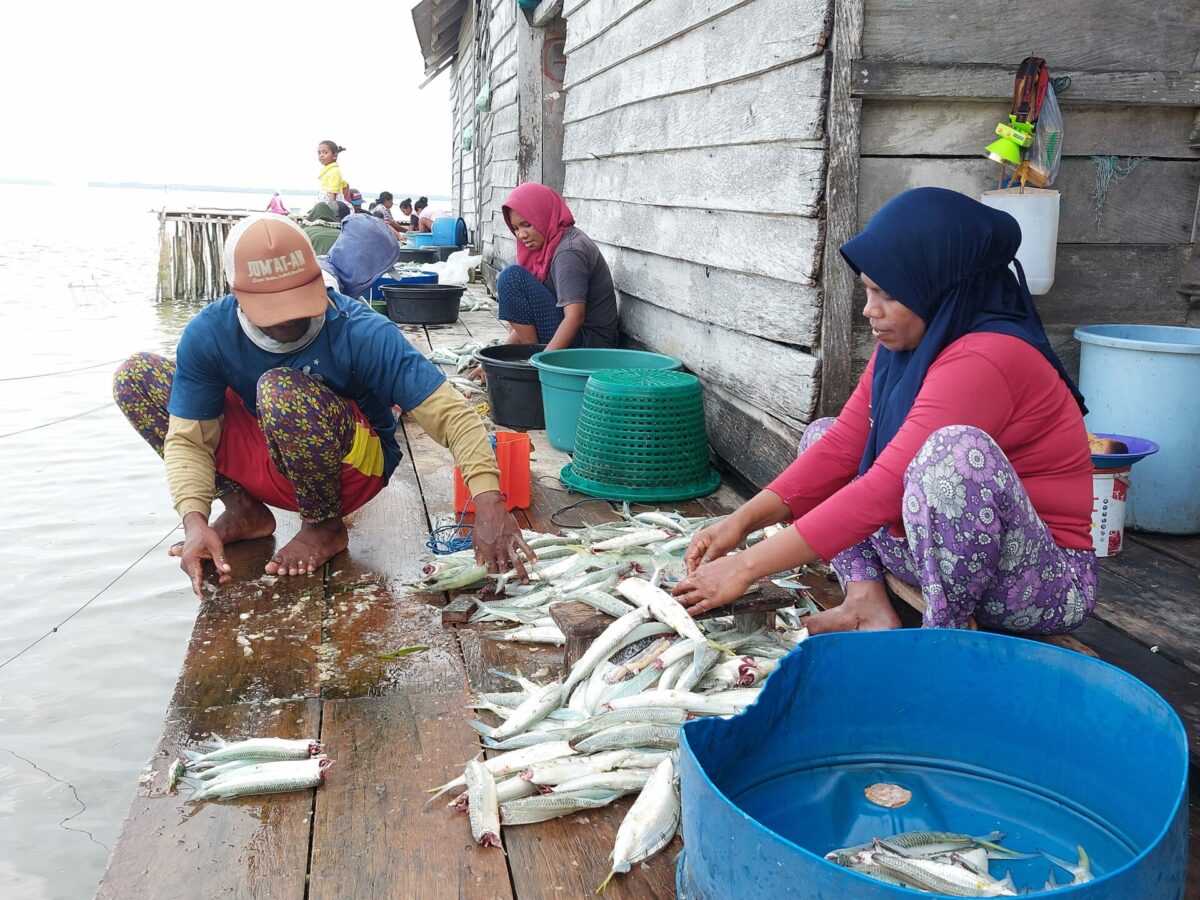
Leny Nurhayanti Rosalin, Deputy for Gender Equality at the Ministry of Women’s Empowerment and Child Protection (PPPA) acknowledges that women fisherfolk are involved in various economic empowerment activities in coastal areas and entrepreneurship in the cultivation of marine products. The PPPA continues to encourage women fisherfolk to access resources and benefits from women’s economic empowerment activities through entrepreneurship. “Women’s contribution to the family economy will become a women’s strength in the decision-making process in their household, including sharing roles in educating and raising children with their husbands more fairly,” said Leny.
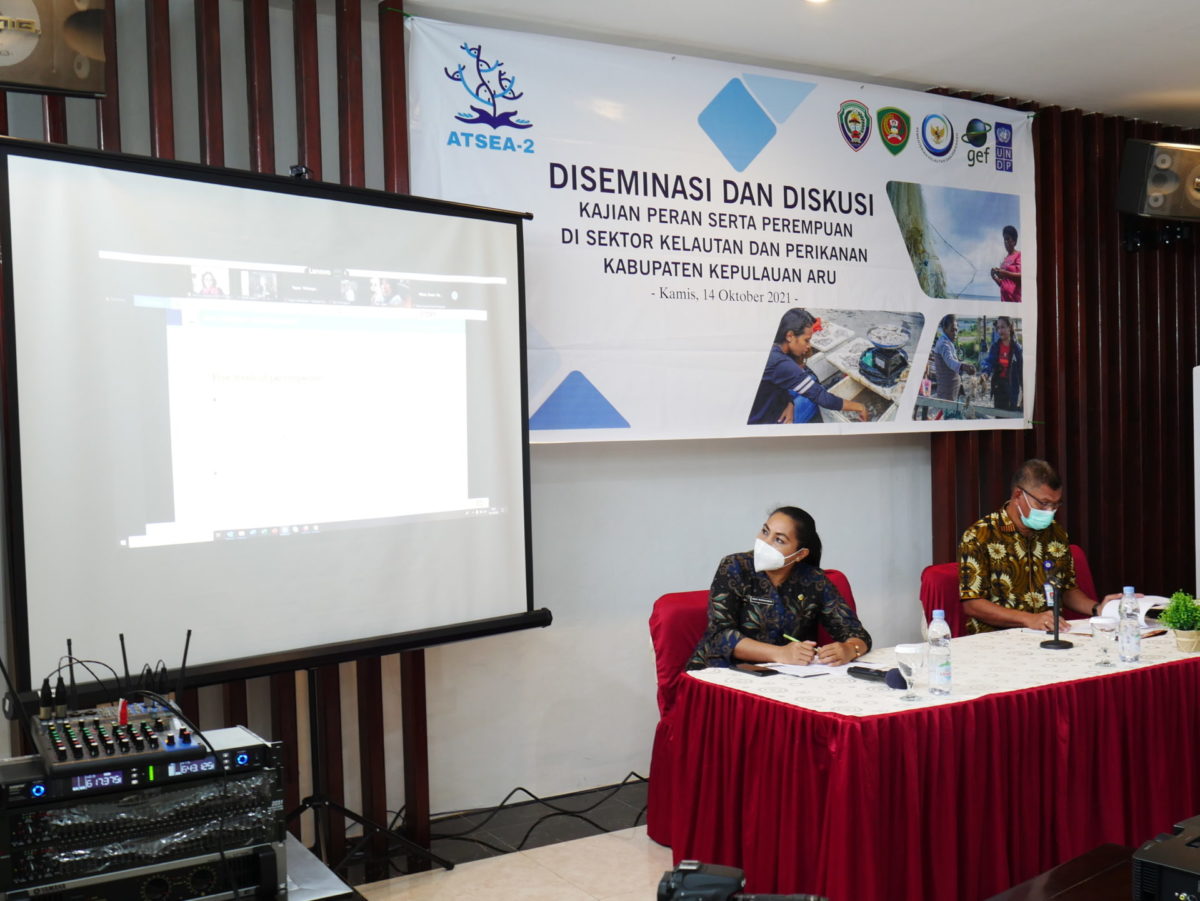
The ATSEA-2 Project conducted a study into gender disparities in the Aru district of Indonesia, revealing that women face segregation in productive, reproductive and public roles, as well as limited participation in decision-making processes within the customary management system. Gender stereotyping and the belief that women lack technical knowledge were identified as factors perpetuating gender issues in the fishing sector. The study results were shared with relevant stakeholders, and a meeting was held to develop an action plan to address gender issues in marine and coastal programs in Aru. The meeting recommended re-establishing a forum for women in the region, facilitating access to civil society organisations and government authorities. The project also plans to hold further discussions to incorporate gender mainstreaming within each program, including shared roles and responsibilities.
Women’s Cooperatives: Nurturing A Brighter Future in Timor-Leste
The Barique Posto Administrativo region of Timor-Leste relies on agriculture, livestock and fishing for income. Women carry a larger share of the financial burden but lack access to information. As part of ATSEA-2’s mission to empower women entrepreneurs in rural areas, the Project recently established a women’s cooperative to improve financial management skills. The cooperative was officially established on 3 June 2022, with 16 women as inaugural members. Since then, members have shown a positive attitude towards managing their expenses and the cooperative has helped members save for future expenses, such as children’s tuition fees.
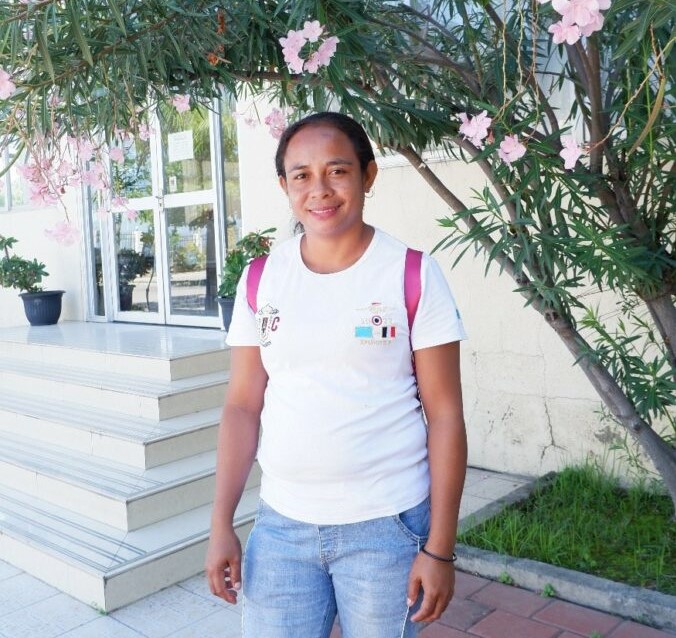
Jacinta Maria Da Cruz, also known as Mana Sinta, is a housewife and a mother of three, who actively participates in the cooperative. She says the women’s cooperative helps her prepare for her children’s education and admits that she previously didn’t know how to manage her income. “Now, I know how to make a budget for my family’s daily expenses – through the women’s cooperative, I can save the extra funds for my children to pay their tuition fees in the future,” she says.
Another story came from Almerindo De Jesus, a livestock farmer, who also benefits from the cooperative and has learned the importance of saving money. Although he is a man, he became interested in becoming a cooperative member and regularly saves money in his account. “I used to be wasteful and never thought of saving my income. After becoming a member of the cooperative, I learned that I shouldn’t spend all of my income; I can take half of my money and save the rest for a rainy day,” he explained.
The formation of a women’s cooperative represents the first crucial step in accelerating the development process and increasing women’s participation in organisational and business operations. Moving forward, the ATSEA-2 Project will continue to support opportunities for women in Barique to increase their participation. Prior to the cooperative’s establishment, ATSEA-2 provided training to 43 women in April 2022, in collaboration with the Ministry of Agriculture and Fisheries and the Ministry of Cooperatives of Timor-Leste, to protect coastal people’s livelihoods and prosperity through sustainable integrated principles.
Women Helping to Protect Sea Turtles in Timor-Leste
Sea turtles are essential to maintaining the balance of marine habitats, but their populations have been declining due to poaching, habitat destruction and bycatch. Com Village in Timor-Leste is a nesting site for various turtle species, but human activities have caused a decline in their population. The local community-led conservation group, Grupu Konservativu, has been working to protect the eggs from human exploitation and predators by relocating them to more secure locations. However, the group faces several challenges, including low hatching and release rates, and the need for legal recognition, monitoring training and awareness-raising.
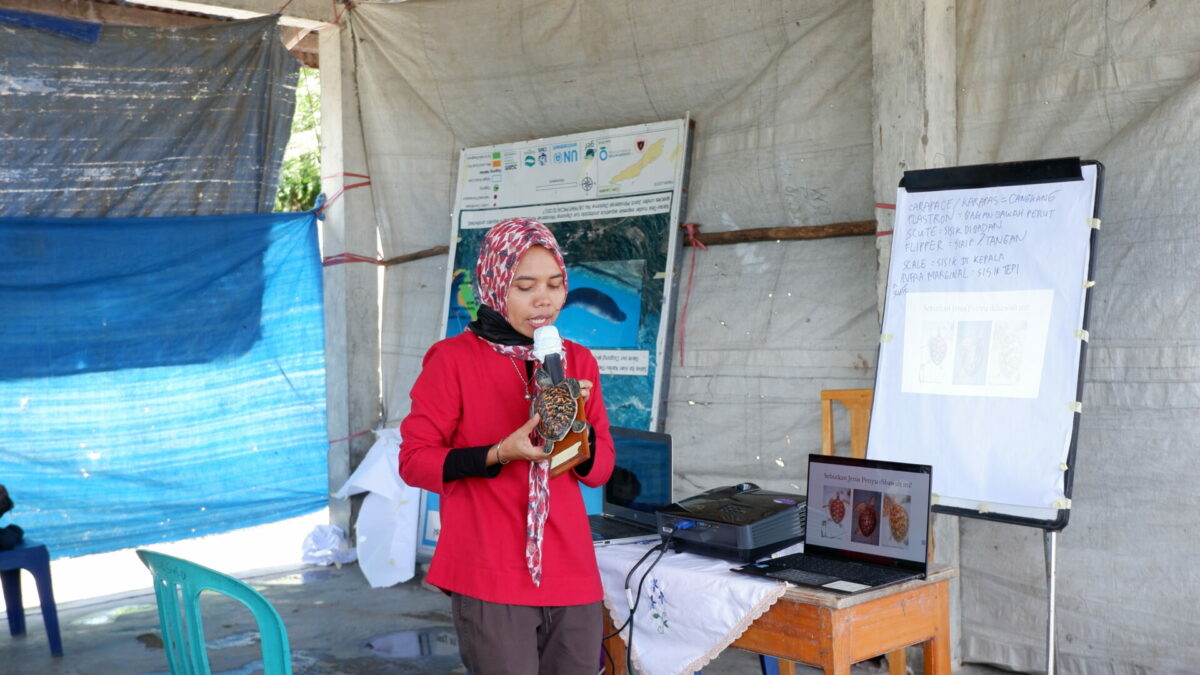
To support the conservation efforts of the group, the ATSEA-2 Project conducted a Sea Turtle Conservation Training session in November 2022. The training was facilitated by a local NGO, PROSPEK, and included expert insights into turtle conservation methods, ecosystem linkages and bacterial growth prevention. The participants showed enthusiasm and commitment to the conservation of marine turtles. The training session was hosted by Dwi Suprapti, a sea turtle expert.
The training represented a crucial first step towards sea turtle conservation in Com Village. Many additional developments will be required in future to help the group function to its optimum capacity: first and foremost, the group will need to apply for and obtain legal recognition; secondly, another training session related to sea turtle monitoring during nesting season would help to develop their understanding of nesting trends in Com; and third, a process of raising awareness and socialisation needs to be conducted, so that villagers in Com and neighbouring areas can understand that sea turtles are fully protected and cannot be harvested.
From the first day of the training, Suprapti said that participants’ enthusiasm was clear to see. Suprapti revealed expert insights into the life of these ancient seafaring reptiles, demonstrating the various linkages between them and other organisms and processes within the ecosystem. In return, participants offered their undivided attention throughout the training, while also reaffirming their commitment to the conservation of marine turtles.
In one example, the secretary of the conservation group, Lucas Monteiro, breathed a sigh of relief after it was confirmed that he needed to change the sand after the eggs hatched to avoid the growth of bacteria – the presence of bacteria can lower the hatching success rate, as explained by Suprapti. This was corroborated by the head of the conservation group, Raul Pereira Mendes, who had noticed in the course of their operations that if they used the same sand, it became slimy and resulted in a lower number of successful hatchlings.
The Grupu Konservativu plans to raise awareness of the protection of sea turtles and develop eco-tourism to provide economic benefits to the local community. The ATSEA-2 Project will collaborate with PROSPEK to support them in Com.
Women’s Group in Manufahi Play a Significant Role in Improving Seafood Processing Skills
In addition to Dwi Suprapti, who actively supports the community-led conservation group in Com Village, The ATSEA-2 Project has seen big improvements in terms of women’s seafood processing skills in Manufahi municipality in Timor-Leste. Here, there are days when more fish are caught than can be consumed or sold, while at other times, seafood must be preserved due to unpredictable supply chains (an issue that has been especially pertinent during the pandemic). This has led to economic uncertainty, with many struggling to make ends meet.
According to the Ministry of Agriculture and Fisheries’ Rapid Food Security Assessment in 2020, households had 10% less fish than the previous year, and food storage levels were lower. To address this issue, the ATSEA-2 Project collaborated with the Ministry of Agriculture and Fisheries to train women’s groups from Betanu, Uma-Berloi, and Clacuc villages on seafood processing techniques, sanitation, and hygiene to prevent spoilage and prolong shelf life. The training, taking place in September 2021, was attended by high-ranking officials from the Ministry of Agriculture and Fisheries, who highlighted the importance of the program’s goals. The focus in Manufahi Municipality is on the development of the Betano to Claluc Marine Protected Area, integrated coastal management plans and sustainable fish feed production through an Ecosystem Approach Fisheries to Management (EAFM).

Women’s Role and Involvement in an Ecosystem Approach to Fisheries Management in Papua New Guinea
Papua New Guinea is a country rich in natural resources. Its exclusive economic zone of 3.1 million square kilometres plays host to abundant tuna resources and diverse marine fisheries. However, the country has continued to suffer serious environmental degradation over the past decade, due to unsustainable resource use practices, habitat destruction, pollution and poor environmental governance.
The village community in South Fly, Papua New Guinea, which is one of the ATSEA-2 Project working areas, relies on fishing and marine resources for their livelihoods. However, overfishing and illegal fishing have put a strain on these resources, causing a decline in their availability. To help the villagers better manage their fisheries, a training session was conducted by the ATSEA-2 Project team, which focused on using an Ecosystem Approach to Fisheries Management (EAFM).
Conducted in August 2022, the training included group activities that helped participants identify issues in fisheries management, prioritise goals and establish a vision for future management. The villagers expressed their appreciation for the training and plan to develop committees to enforce compliance. Concurrent with the training was the public consultation on the South Fly Artisanal Fishery Management Plan, which was subsequently updated with feedback and then authorised by the National Fisheries Authority. The ATSEA-2 Program supports the implementation of environmental and governance objectives in the Arafura and Timor Seas region.
“South Fly coastal community village depends on fishing,” said Ms. Dainah Gigiba in her welcoming address to the ATSEA-2 training team and participants from the South Fly Fisheries Office. “This training will be very useful for the villagers to properly manage their fisheries resources,” she added.
In total there were 23 people who attended the training, four of whom were women. This group included various fisheries managers and representatives from 12 South Fly villages, Western Province fisheries, South Fly District fisheries, South Fly District courts, the National Fisheries Authority, the Conservation & Environmental Protection Authority and ATSEA-2.
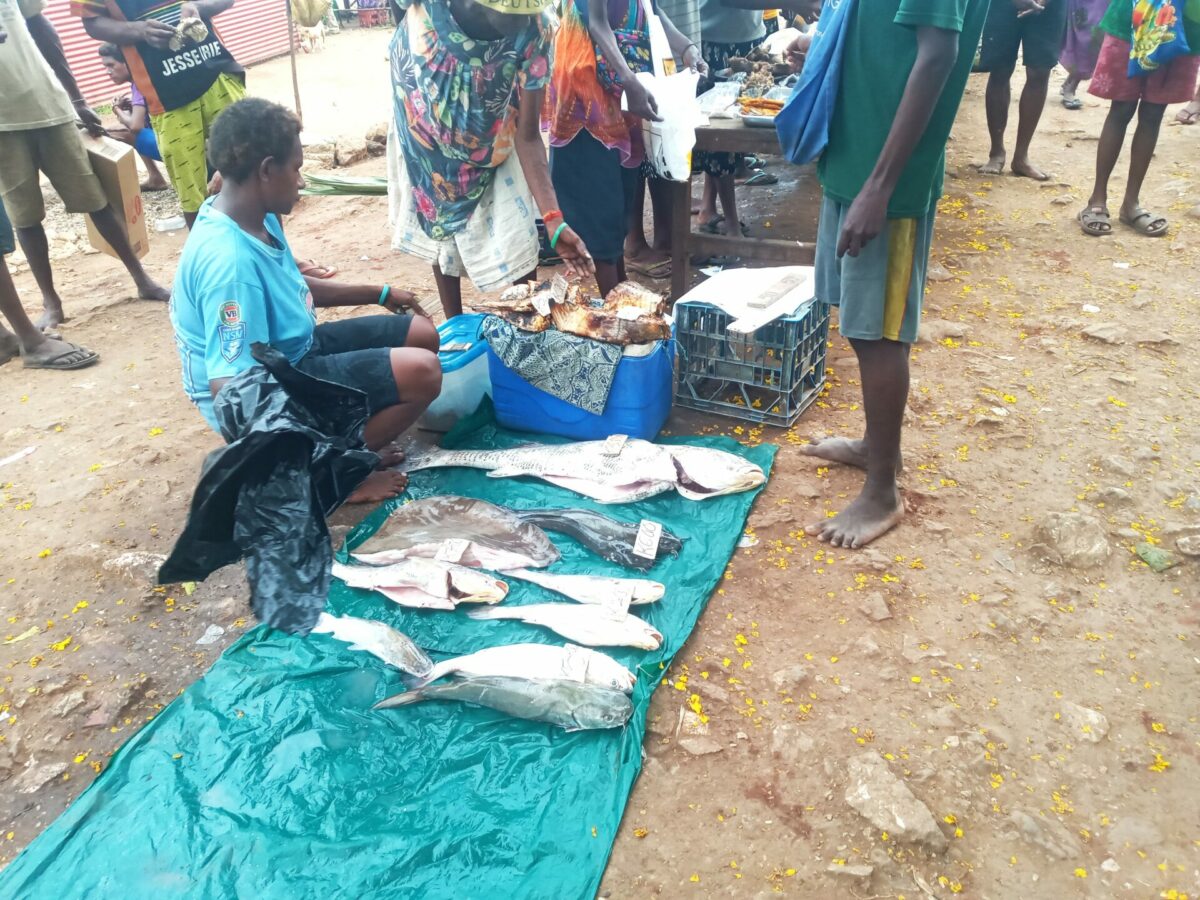
In another part of the coastal area, the Fore-coast Kiwai region, women have an important but different role in fishing compared to men. While men go out to sea and set fishing nets, women fish for crabs and shellfish in mangrove forests and use small nets along the beaches. They also cast lines close to the coast and sometimes use poison roots when accompanying men to reefs. Women collect the bait needed for deep lining and contribute to a range of catches. They are also responsible for preparing and processing the catch, including cleaning, sorting, cooking and selling at markets.
However, women are not as active in some areas, such as deep lining and fishing in reefs, due to societal expectations. There is also a problem with accessibility to markets, making it difficult for women to sell their catch and benefit financially. It is hoped that in the future, more women will engage in these fields and that accessible markets will be available so that all fisherfolk can improve their lives and provide for their families.
